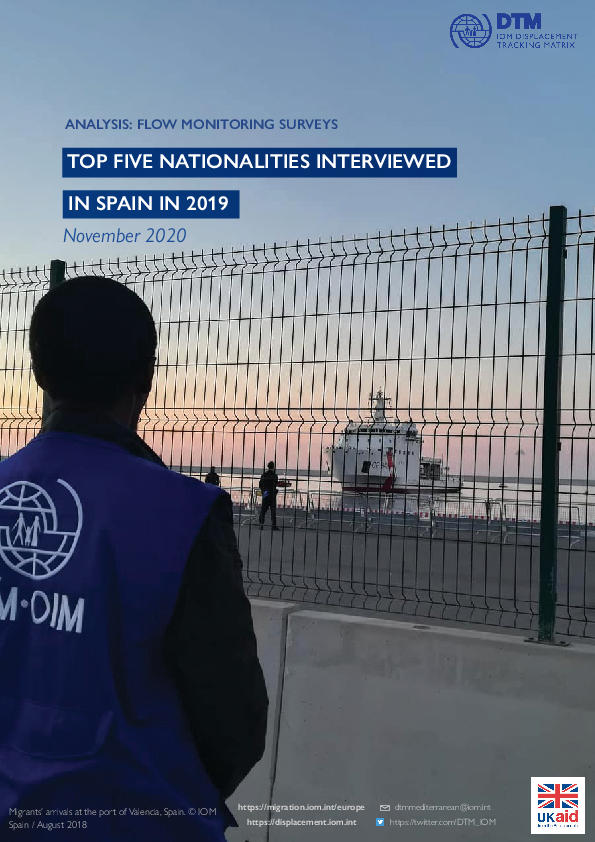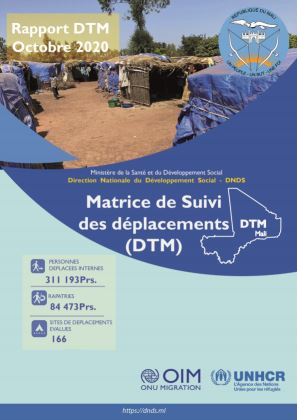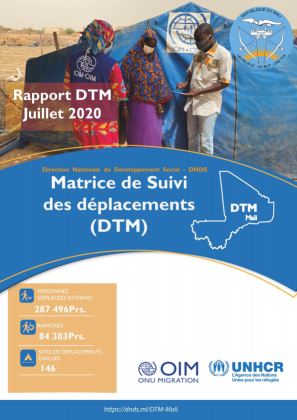-
Countries
-
Data and Analysis
-
Special Focus
-
Crisis Responses
Return Intention

Contact
DTM Mediterranean, DTMMediterranean@iom.int
Language
English
Location
Bosnia & Herzegovina
Period Covered
Nov 01 2019
Dec 31 2019
Activity
- Survey
- Flow Monitoring Survey
- Return Intention
- Flow Monitoring
Between November and December 2019, DTM field team conducted 354 valid surveys in two different locations in Bosnia and Herzegovina, capturing journey experiences of newly arrived migrants and refugees.
This report focuses on the analysis of the profiles, experiences and vulnerabilities of respondents surveyed in Bosnia and Herzegovina. Due to the limited number of interviews, all surveyed are analyzed together.
The flow monitoring surveys (FMS) are part of the IOM’s Displacement Tracking Matrix (DTM) activities in the Mediterranean that started in October 2015 and are conducted within the framework of IOM’s research on populations on the move through the Mediterranean and Western Balkan Routes to Europe. The collected surveys are regularly analysed and provide information on profiles of migrant and refugees, transit routes and vulnerabilities. All analyses together with the latest information on arrivals to Europe can be accessed via DTM´s Flow Monitoring Europe Geoportal. The survey gathers information on profiles of migrants and refugees, including age, sex, areas of origin, levels of education, as well as employment status before migration, key transit points on their route, the cost of the journey, vulnerabilities, reasons for moving and intentions.

Contact
southsudanDTM@iom.int
Language
English
Location
South Sudan
Period Covered
Aug 01 2020
Sep 30 2020
Activity
- Other
- Community Perception
- Return Intention
This reports contains summary of findings from the consultation process with affected communities in South Sudan for the UN Secretary-General's High Level Panel on Internal Displacement (HLP on IDPs) conducted through a series of focus group discussions and key informant interviews between August and September 2020. Consultations were conducted jointly by six agencies and organizations - IOM, CARE International, Danish Refugee Council (DRC), Plan International, UNHCR and NCA - Act Alliance over following topics: Durable Solutions, Prevention, Participation and Accountability, Protection, Coordination, Humanitarian-Development-Peacebuilding Nexus, Specific Needs and Capacities and COVID-19.

Contact
DTM Mediterranean, DTMMediterranean@iom.int
Language
English
Location
Spain
Period Covered
Jul 01 2019
Sep 30 2019
Activity
- Survey
- Flow Monitoring Survey
- Return Intention
- Flow Monitoring
This report is based on the Flow Monitoring Surveys carried out by IOM field staff in Spain between July and September 2019. A total 994 interviews were collected in 36 different locations in Madrid, Andalucía, Melilla and Ceuta to provide an insight of the profile of migrants and refugees who had arrived
in the country. This report provides analysis of migrants’ demographic profile, transit routes, reasons for leaving countries of origin or habitual residence, and their future travel intentions. Specifically, it focuses on the comparison between top five nationalities surveyed in Spain.
The five nationalities include respondents from Côte d’Ivoire (194 individuals), Guinea (155), Mali (145), Algeria (118) and Morocco (113). These five nationalities constitute 73 per cent of all respondents. The remaining 23 per cent were individuals of 30 different nationalities (including nationals of Senegal, Tunisia, Yemen, Cameroon, Mauritania, Nigeria and Bangladesh). The selected sample of the top five nationality groups consists of 725 interviews. The top five nationality groups in the sample are also among the top nationalities of arrivals by sea registered by the Spanish authorities between July and September 2019. Morocco was the first country of origin of arrivals by sea in 2019 (32%), followed by Algeria (20%), Côte d’Ivoire (7%), Guinea (5%) and Mali (5%).
Flow Monitoring Survey (FMS) is one of the components implemented under DTM portfolio in Europe. Aside from the primary data collection through direct interviews, it includes also collation of statistical information products, based on secondary data revision. Compilation of available data and information is released on monthly, quarterly and yearly basis, together with a comprehensive dataset. All reports, together with the latest data on arrivals from national authorities and IOM country offices, can be accessed via DTM´s Flow Monitoring Europe Geoportal.

Contact
DTM Mali, DTMMali@iom.int
Language
French
Location
Mali
Period Covered
Oct 01 2020
Oct 31 2020
Activity
- Survey
- Return Intention
- Flow Monitoring
- Mobility Tracking
- Baseline Assessment
La crise sécuritaire que le Mali a connu en 2012 a provoqué d’importants déplacements de populations tant à l’intérieur du territoire que vers les pays limitrophes. Afin d’orienter la réponse humanitaire et de faciliter le retour et la réintégration des personnes déplacées internes (PDIs) et des réfugiés, la Direction Nationale du Développement Social (DNDS), fournit depuis décembre 2014 des informations à l’ensemble de la communauté humanitaire et aux pouvoirs publics afin de répondre aux besoins des populations déplacées, retournées et rapatriées au Mali. Les opérations de collecte et de mise à jour des données menées dans le cadre du programme DTM montrent une augmentation du nombre de personnes déplacées au Mali entre juillet et octobre 2020. La population déplacée dans la région a augmenté de 8,2% par rapport à juillet (rapport DTM de juillet 2020). Le nombre de PDIs est en effet passé de 287 496 personnes (rapport DTM juillet 2020) à 311 193 en octobre 2020 soit une augmentation de 23 697 individus. Cette augmentation s’explique par l’aggravation des conditions sécuritaires dans les Régions de Ségou, Mopti, Tombouctou, Gao et Ménaka au cours des derniers mois, engendrant de plus en plus de déplacements.

Contact
DTM Cameroun, DTMCameroon@iom.int
Language
French
Location
Cameroon
Period Covered
Aug 17 2020
Aug 24 2020
Activity
- Survey
- Return Intention
La Matrice de Suivi des Déplacements (Displacement Tracking Matrix – DTM, en anglais) est un outil mis en place par l’Organisation Internationale pour les Migrations (OIM), qui permet de faire le suivi des déplacements et la mobilité des populations. Elle collecte des informations à différents niveaux, les traite et les diffuse afin de garantir aux acteurs humanitaires, aux gouvernements et autres acteurs intéressés, une meilleure compréhension des mouvements et de l’évolution des besoins des populations déplacées : les facteurs d’influence, les moyens et durées de déplacement, les intentions futures des populations déplacées, leurs conditions de vie et encore bien d’autres éléments sont récoltés auprès de ces populations déplacées.
Ce rapport présente les résultats de la dernière enquête sur les intentions de retour menée auprès des ménages déplacés (Personnes Déplacées Internes (PDI) et réfugiés hors camp) en août 2020 dans la région de l’Extrême-Nord. Il permet ainsi de mieux comprendre le processus de décision des ménages déplacés, les raisons qui les poussent à partir ou les empêchent de revenir et les conditions nécessaires à un retour durable.
La collecte des données a été effectuée entre le 17 au 24 août 2020 par 77 énumérateurs formés et déployés dans chacune des localités évaluées, sous la responsabilité directe de l’équipe DTM. Dans le cadre de cette enquête, 3 055 chefs de ménages PDI et réfugiés hors camp (représentant un total de 24 147 individus) ont répondus au questionnaire dans 712 localités réparties au sein des 6 départements de la région de l’Extrême Nord.

Contact
DTM Mali, DTMMali@iom.int
Language
French
Location
Mali
Period Covered
Jul 01 2020
Jul 31 2020
Activity
- Survey
- Return Intention
- Mobility Tracking
- Baseline Assessment
La crise sécuritaire que le Mali a connu en 2012 a provoqué d’importants déplacements de populations tant à l’intérieur du territoire que vers les pays limitrophes. Afin d’orienter la réponse humanitaire et de faciliter le retour et la réintégration des personnes déplacées internes (PDIs) et des réfugiés, la Direction Nationale du Développement Social (DNDS), fournit depuis décembre 2014 des informations à l’ensemble de la communauté humanitaire et aux pouvoirs publics afin de répondre aux besoins des populations déplacées, retournées et rapatriées au Mali. Les opérations de collecte et de mise à jour des données menées dans le cadre du programme DTM montrent une augmentation du nombre de personnes déplacées au Mali entre avril et juillet 2020. La population déplacée dans la région a augmenté de 8% par rapport à juin (rapport CMP de juin 2020). Le nombre de PDIs est en effet passé de 266 831 personnes (rapport CMP de juin 2020) à 287 496 en juillet 2020 soit une augmentation de 20 665 individus. Cette augmentation confirme l’aggravation des conditions sécuritaires dans les Régions de Mopti, Ségou, Tombouctou, Gao et Ménaka et la bande frontalière Mali-Burkina Faso-Niger au cours des derniers mois, engendrant de plus en plus de déplacements.
A report by IOM’s Displacement Tracking Matrix (DTM) identified 4.2 million displaced individuals in Nigeria, Chad, and Cameroon in 2019. However, as the protracted conflict begins to subside in some regions, there are a growing number of displaced persons returning to their towns and villages of origin. The DTM noted a 77 per cent increase (800,000 individuals) in the number of returnees in 2019 compare those reported in 2016. The total population of returnees represents 41 per cent of the total population affected by displacements in the Lake Chad Basin. This growing trend towards return movements calls for a more thorough investigation to better understand the returnee populations in the regions and communities of origin. It is also highlighting the importance of assessing the return intentions of individuals who are still displaced in order to provide the necessary assistance for the reintegration of those who have already returned to their area of origin, as well as to those who intend to return in the near future.
The stability index identifies ‘pockets of stability’ to target the needs of the large proportion of returnee populations and analyzes which factors are relatively more impactful on the decisions of returnees to remain in place or to move. Furthermore, it is an essential tool in designing assistance for durable solutions as well as a new instrument to inform transition and recovery with appropriate programming priorities.
This report presents the results of the Stability Index data collection activities conducted in Nigeria and Cameroon in August and September 2019.

Contact
DTM Iraq, IraqDTM@iom.int
Language
English
Location
Iraq
Period Covered
Jul 01 2020
Jul 31 2020
Activity
- Survey
- Return Intention
- Mobility Tracking
- Baseline Assessment
The Return Index is a tool designed to measure the severity of conditions in locations of return. Data collection for the Return Index Round 9 took place during the months of May and June 2020 across eight governorates, 38 districts and 2,013 locations in Iraq. During Round 9, an additional 163 locations of return were assessed.

Contact
DTM Burundi, DTMBurundi@iom.int
Language
French
Location
Burundi
Period Covered
Jul 01 2020
Jul 31 2020
Activity
- Survey
- Return Intention
En date du 19 April et 1 Mai 2020, la province de Bujumbura Rural, commune de Mutimbuzi, zone de Gatumba a été touchée par des fortes inondations qui ont affecté plus de 45,000 personnes inclues 17,792 déplacés. Ces personnes déplacées sont installées dans quatre sites temporaires (Kigaramango, Kinyinya II, Sobel (Maramvya) et Mafubo). Dans le cadre des enquêtes sur les intentions de retour des ménages déplacés due aux inondations, 552 ménages déplacés ont été sélectionnés d’une façon aléatoire dans ces sites.

Contact
DTM REMAP Support Team, dtmremap@iom.int
Language
English
Location
Bangladesh
Period Covered
Jan 01 2019
Dec 31 2019
Activity
- Survey
- Flow Monitoring Survey
- Return Intention
One key finding of the report is that Bangladeshi regular and irregular potential migrants share many characteristics. Regular and irregular potential migrant respondents were the same ages and had similar levels of education and employment prior to the decision to migrate. Furthermore, 71 per cent of regular potential migrants also paid migration facilitators for assistance with their migration, and they paid similar amounts as irregular potential migrants did. Another insight is that potential migrants were driven to migrate by the possibility of improved work opportunities and support from a strong social network. Many respondents were planning to move to a destination where they already had family or friends. Many potential migrants were moving elsewhere in the Global South, rather than to a country in the Global North.
Pagination
- Previous page
- Page 25
- Next page

